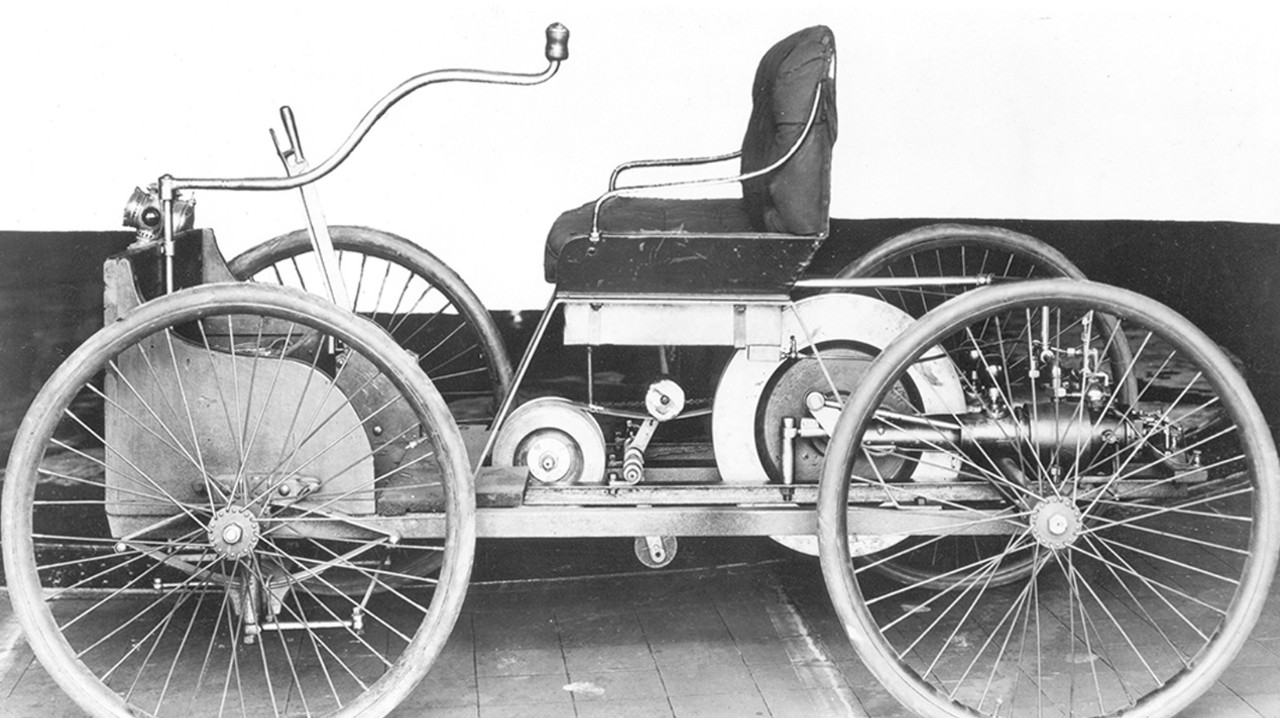The History of Henry Ford’s Quadricycle – 1896

IN 1896, THE FOUNDER OF FORD MOTOR COMPANY BUILT HIS FIRST CAR AND TOOK IT FOR A SPIN ON THE STREETS OF DETROIT.
In the early morning of June 4, 1896, Henry Ford made his most memorable preliminary attempt in a little, four-wheeled vehicle he called a “Quadricycle,” consequently portrayed by antiquarian Allan Nevins as “Strikingly little and light – the lightest vehicle of its sort yet delivered.” This Quadricycle had 49-inch wheelbase and was 79 inches long generally speaking. It was just 45 inches wide and 43 inches high. For the 32-year-old designer, the Quadricycle’s fruitful first trip was the consequence of the imaginativeness, assurance and difficult work that later procured him the title of “virtuoso of the auto business.”
Three goliaths – steel, oil and rail lines – set up for Henry Ford and the starting points of engine transportation. In 1864, a year after Mr. Ford’s introduction to the world, the open-hearth process was created and the cutting edge time of steel started. The next year, the oil business laid the primary stretch of pipelines in the Allegheny River Valley. In 1869, the American mainland was connected from east to west by the rail route.
From his childhood days, Henry Ford was an expert of mechanical rationale. From a look at a machine he could grasp the between reliance of its parts and follow the communication of cog wheels, ratchets, prods, cams and switches. As per his dad, William Ford, neighbors alluded to Henry as a young fellow with “wheels in his mind.” After venturing out from home – a little ranch right external Detroit – at 16 years old, he turned into an understudy in a Detroit machine shop that made steam motors. Inside a couple of years, he had become boss specialist of the Edison Illuminating Company. His partners portrayed him as “exceptionally capable as a technician and as a functional specialist.”
However, it was sufficiently not. In the mid 1890’s Henry Ford started fiddling with a little vehicle in a little studio at the back of his home at 58 Bagley Avenue in Detroit, a couple of blocks from the Edison plant. Around then, any man exploring different avenues regarding “horseless carriages” was viewed as something of a peculiarity.
An older Detroiter said Henry Ford – no exemption for this biased rule – was respected with some doubt around the area. The youthful designer was upheld by his better half, Clara, whom he had hitched in 1888, and by the assistance of companions and partners from the Edison Company – David Bell, Jim Bishop, George Cato and “Bug” Huff.
Henry Ford’s initial engine spluttered its direction into history on Christmas Eve in 1893 – that very year his main child, Edsel Bryant Ford, was conceived. For the following couple of years, he explored different avenues regarding motor plans, yet he didn’t start work on the last bigger engine for his Quadricycle until January 1896. A little later he started fabricating the frame and body of the carriage.
A long time before the Quadricycle was done, he worked many evenings until late or later, and the entire constantly Saturdays. As per Allan Nevins, Ford wouldn’t fret the extended periods. “I can’t say that it was difficult work,” he noticed years after the fact. “No work with interest is ever hard.” He was certain of the outcomes – “they generally come on the off chance that you buckle sufficiently down.”
Aside from the engine, wheels, axles and guiding turner, the vehicle was built of wood, and weighed just 500 pounds, without fuel. It had a buggy-like seat and ran on bike size wheels with pneumatic tires. Portage’s “horseless carriage” had two rates – 10 and 20 miles each hour chose by twin drive belts. It had an unbiased stuff yet no converse. Gear changes were made by a grasp switch mounted on the floor to one side of the driver. Last drive was by a solitary chain. There were no brakes, yet Ford incorporated a doorbell as a horn. During the two days before his innovation was done, Ford barely rested by any stretch of the imagination. At long last, in the early morning long stretches of June 4, 1896, the vehicle was prepared.
As Ford ready for his most memorable ride, he understood the finished Quadricycle was more extensive than the carport entryway. With a hatchet, he broke out edge and blocks to broaden the opening and carried the vehicle out into the back street. With his better half and a partner, Jim Bishop, restlessly watching, Ford put the grasp in unbiased and turned the flywheel.
The engine became fully awake! Portage drove the Quadricycle gradually along neighboring Detroit roads, with Bishop on a bike in front of him and a couple of inquisitive passers-by gazing distrustfully. A spring inciting one of the “ignitors” fizzled during the short run, however it was immediately fixed, and the two men returned victoriously to the Ford home, got a couple of long stretches of rest and afterward revealed for work at Edison.
Albeit the trip was fruitful, Ford was not fulfilled, and he essentially revamped the Quadricycle before long. He and his partners supplanted numerous wooden parts with metal, introduced a cooling framework in the motor, and fitted sturdier wheels. Henry Ford in this way constructed different vehicles and on June 16, 1903 – seven years after his most memorable preliminary attempt – he sent off the Ford Motor Company in a little changed over carriage production line in Detroit. Henry Ford sold the Quadricycle sometime thereafter for $200, however he repurchased it in 1904 for just $65, it actually endures today in an extremely durable showcase at the Henry Ford Museum in Dearborn, Michigan.